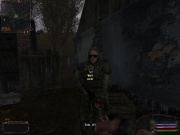Actor Editor Import/Export Tutorial
From Mod Wiki
Ok, since there's like no documentation on this tool I though I'd do a small tutorial on it. Hopefully, it will get some people interested in adding things like characters models and such.
First off download Xray Asset Tools (http://www.mediafire.com/?ynowommqiow). It will provide you with the required plugins for maya, and Milkshape, as well as a converter to convert models to .object, .bones, and .skl(s).
Then make sure you have the Xray SDK installed. (http://files.gsc-game.com/st/xray-sdk-setup-v0.4.exe) [Note: If you're running Vista or Win7, you will have to set the .exe files in /bin/ to compatibility mode with Windows XP SP2.]
Now few things you should know: make sure the textures on the model point to a .dds (Direct Draw Surface.) and that you place them in /X-Ray SDK/level_editor/gamedata/textures/act. They can really be in any folder, but it's for organizational purposes. Copy the animation meshes from SHOC (they should be in Meshes/Actors once you extract the .db's) to /X-Ray SDK/level_editor/gamedata/meshes/actors/. You'll need them in a bit.
- Before doing anything Select Preferences (within Actor Editor) and expand the Object Tree, and select Skeleton, now check all the dots.
- Ok once you got your model exported as .object (via one of the converters) Go to File > Load and select the .object you just exported!
- Now you may get some missing texture errors, don't worry.
- Click Object in Object Items Group and check "Make Progressive".
- Under Object Items group, Expand the Surfaces tree and select each surface, and point them to the correct texture.
- Next Click on Motion (In Object Items Group) and if you have a .Skl(s) file already extracted you can click Edit > Append, and load it from there, if not click the ... on Motion reference, and select an animation set. Note: For animations to work the model must have THE EXACT SAME NUMBER OF BONES else you'll get an error. If your STALKER model is just a normal STALKER simply select Stalker_Animation and click OK.
- Now lastly, the collision/hit detection(?) Expand the Bones Tree (In Object Items Group.) Now if you already converted a ogf to .bones this should take a few seconds, if you haven't then you'll manually have to create the collision model for each bone.
- If you haven't click on a bone name, change the game material to "Creatures > Human" and change the type either a box, sphere or cylinder. And adjust the length, height, and position of it all..(Will take quite a while.)
- If you have a .bones file (You can extract them from ogf's using converter.exe, see the docs that come with it.) Click on Bones, and select load, browse to the .bones and click ok.
- Now it's finally time to test it out in the editor, click Engine under the Model Group. It'll compile the model so it may take a while.
- Once thats done the model may seem like it's broken, don't fear! simply expand the Motions tab, and Slot1 and select an animation. (You may also get a error box, ignore it...click continue and ok..)
- Once you're done fooling around with the model. Set it back to Editor Mode and Click File > Save, and then finally File > Export > OGF. And it'll compile the model (It may take a while!)
- And then you're done!

